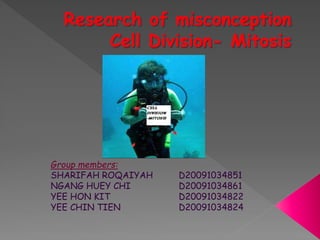Cell division- Mitosis
- 1. Group members: SHARIFAH ROQAIYAH D20091034851 NGANG HUEY CHI D20091034861 YEE HON KIT D20091034822 YEE CHIN TIEN D20091034824
- 4. Ob jec tiv e Pur po se • This study aims to investigate the effect of drawing method of determining university students’ misconceptions concerning cell division – mitotic cell cycle.  To identify biology student teachers’ misconceptions of cell divisions using drawings and interviews which they possess about the cell division processes and both the content and scope of these misconceptions.
- 5. Simple research instruments Taps holistic understanding An alternative form of expression Can be completed quickly, easily and in an enjoyable way.
- 6. 1. A total of 124 student teachers, who were studying to become secondary biology teachers at the Faculty of Education in Selcuk University in Turkey. 2. Participants previously had studied cell division in cytology, genetics, and molecular biology, as a school subject during various semesters.
- 7. • Biology student teachers’ understanding of the chromosomes mitosis was examined by two different methods not mutually exclusive. • The first method is method of drawing. The participants were informed about the drawing method before this application and some practices were applied about this method. • The participating students were asked to draw process of mitosis in a cell on a blank piece of A4-sized paper.
- 8. • These drawings are analyzed and categorized into model types corresponding to five levels of understanding. 1. No drawing 2. Non-representational drawings, 3. Drawings with misconceptions, 4. Partial drawings 5. Comprehensive representation drawings.
- 9.  The second method to examine the university student’s knowledge is individual interviews.  After the drawings were evaluated, individual interviews were conducted about the detailed subjects with 15 randomly chosen who demonstrated misconceptions.  The purpose was to check the validity of the interpretation of the drawings.  In the interview, these students were asked to respond to questions like: › What are chromosomes and sister chromatids? › How do the chromosomes act during mitosis?
- 10. Research about misconception of cell division -mitosis Examined by two different methods Method of drawing, conducted with two phases. 1st phase, the participants were informed about the drawing method before this application 2nd phase, the question “Draw process of mitosis in a cell” was asked Analysis of drawings and categorized into model types corresponding to five levels of understanding 1)No drawing 2) Non-representational drawings 3) Drawings with misconceptions 4)Partial drawings 5) Comprehensive representation drawings Second method - individual interviews. Conducted about the detailed subjects with 15 randomly chosen who demonstrated misconceptions.
- 11. Figure 1. Example of level 2 (non-representational drawing).
- 12. Figure 2. Example of level 3 (drawing with misconception).
- 13. Figure 3. Examples of level 4 (partial drawing).
- 14. Figure 4. Examples of level 5 (comprehensive representation drawing).
- 16. Misconception Scientific Idea 1. Interphase is the resting phase of mitosis. 2. The chromosome number is doubled in the prophase of mitosis and halved in the anaphase of mitosis. 3. In mitosis, homologous chromosomes separate in the anaphase. 4. Sister chromatids do not separate in mitosis. 5. The number of chromosomes is halved after mitosis. 6. The number of chromosomes is doubled after mitosis. 1. Interphase is the first stage in mitotic cell cycle in which the cell grows and replicates its DNA before undergoing mitosis (M phase) and cytokinesis. 2. In the anaphase of mitosis, the spindle separates the two sister chromatids(not chromosome) of each chromosome and moves them to opposite spinde poles. 3. <same as 2> 4. <same as 2> 5. After mitosis, two daughter cells are genetic duplicates of the parental cell that entered mitotic division are produced. 6. <same as 5>
- 17. Figure 8. A drawing of misconception of “interphase is the resting phase of the mitosis”.
- 23.  Misconceptions of cell division held by student teachers in biology: A drawing analysis  Scientific Research and Essay Vol. 5 (2), pp. 235-247, 18 January, 2010 Available online at http://www.academicjournals.org/SRE ISSN 1992-2248 © 2010 Academic Journals
Editor's Notes
- #4: G1 phase (period of cell growth before the DNA replicates) S phase (period when DNA replicates and chromosomal proteins are duplicated) G2 phase ( Period after DNA replicates ,cell prepares for division)
- #6: that enable easy comparisons at the international level. As a technique for exploring ideas, drawing taps holistic understanding and prevents children from feeling constrained by trying to match their knowledge with that of the researcher for children to express their thoughts verbally
- #9: We will see the differences between these level of understanding after this.
- #11: The diagram show the flow of this misconception research which will enable all of you to understand about this research more easily.
- #12: This is one of the example of level 2 model types of understanding























